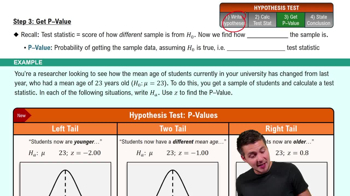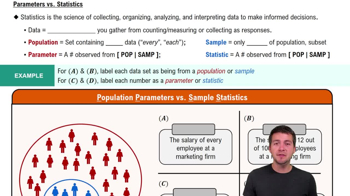A candy manufacturer seeking to minimize the variation in weights of their candies claims to produce candies with a standard deviation less than g. Write the null and alternative hypotheses.
Table of contents
- 1. Intro to Stats and Collecting Data1h 14m
- 2. Describing Data with Tables and Graphs1h 55m
- 3. Describing Data Numerically2h 5m
- 4. Probability2h 16m
- 5. Binomial Distribution & Discrete Random Variables3h 6m
- 6. Normal Distribution and Continuous Random Variables2h 11m
- 7. Sampling Distributions & Confidence Intervals: Mean3h 23m
- Sampling Distribution of the Sample Mean and Central Limit Theorem19m
- Distribution of Sample Mean - Excel23m
- Introduction to Confidence Intervals15m
- Confidence Intervals for Population Mean1h 18m
- Determining the Minimum Sample Size Required12m
- Finding Probabilities and T Critical Values - Excel28m
- Confidence Intervals for Population Means - Excel25m
- 8. Sampling Distributions & Confidence Intervals: Proportion1h 12m
- 9. Hypothesis Testing for One Sample3h 29m
- 10. Hypothesis Testing for Two Samples4h 50m
- Two Proportions1h 13m
- Two Proportions Hypothesis Test - Excel28m
- Two Means - Unknown, Unequal Variance1h 3m
- Two Means - Unknown Variances Hypothesis Test - Excel12m
- Two Means - Unknown, Equal Variance15m
- Two Means - Unknown, Equal Variances Hypothesis Test - Excel9m
- Two Means - Known Variance12m
- Two Means - Sigma Known Hypothesis Test - Excel21m
- Two Means - Matched Pairs (Dependent Samples)42m
- Matched Pairs Hypothesis Test - Excel12m
- 11. Correlation1h 6m
- 12. Regression1h 50m
- 13. Chi-Square Tests & Goodness of Fit1h 57m
- 14. ANOVA1h 57m
9. Hypothesis Testing for One Sample
Steps in Hypothesis Testing
Problem 5.1.28
Textbook Question
Stem Cell Survey In a Newsweek poll of 882 adults, 481 (or 55%) said that they were in favor of using federal tax money to fund medical research using stem cells obtained from human embryos. A politician claims that people don’t really understand the stem cell issue and their responses to such questions are random responses equivalent to a coin toss. Use the following probabilities related to determining whether the result of 481 is significantly high (assuming the true rate is 50%). Is 481 significantly high? What should be concluded about the politician’s claim? Explain.
P(respondent says to use the federal tax money) = 0.5
P(among 882, exactly 481 says to use federal tax money) = 0.000713
P(among 882,481 or more say to use federal tax money) = 0.00389
 Verified step by step guidance
Verified step by step guidance1
Step 1: Define the null hypothesis (H0) and alternative hypothesis (H1). The null hypothesis assumes that the responses are random and equivalent to a coin toss, meaning the true proportion of people in favor is 0.5. The alternative hypothesis suggests that the proportion is significantly different from 0.5.
Step 2: Identify the given probabilities and their relevance. The problem provides P(respondent says to use federal tax money) = 0.5, P(among 882, exactly 481 says to use federal tax money) = 0.000713, and P(among 882, 481 or more say to use federal tax money) = 0.00389. The last probability, P(481 or more), is the cumulative probability used to determine if the observed result is significantly high.
Step 3: Determine the significance level (α). Typically, a significance level of 0.05 is used unless otherwise specified. Compare the cumulative probability P(481 or more) = 0.00389 to the significance level. If this probability is less than α, the result is considered significantly high.
Step 4: Interpret the result. Since P(481 or more) = 0.00389 is less than 0.05, the observed result of 481 respondents in favor is significantly high. This suggests that the responses are not random and are unlikely to be equivalent to a coin toss.
Step 5: Conclude about the politician’s claim. Based on the statistical evidence, the claim that people’s responses are random and equivalent to a coin toss is not supported. The data indicates that there is a significant preference among respondents in favor of using federal tax money for stem cell research.
 Verified video answer for a similar problem:
Verified video answer for a similar problem:This video solution was recommended by our tutors as helpful for the problem above
Video duration:
2mPlay a video:
Was this helpful?
Key Concepts
Here are the essential concepts you must grasp in order to answer the question correctly.
Hypothesis Testing
Hypothesis testing is a statistical method used to determine whether there is enough evidence to reject a null hypothesis. In this context, the null hypothesis would state that the proportion of adults in favor of funding stem cell research is 50%. By comparing the observed result (481 supporters) to the expected result under the null hypothesis, we can assess whether the observed data is statistically significant.
Recommended video:
Guided course

Step 1: Write Hypotheses
P-Value
The p-value is a measure that helps determine the significance of the results obtained in a statistical test. It represents the probability of observing a result as extreme as, or more extreme than, the one obtained, assuming the null hypothesis is true. In this case, the p-value of 0.00389 indicates a very low probability of obtaining 481 or more supporters if the true proportion is indeed 50%, suggesting that the result is statistically significant.
Recommended video:
Guided course

Step 3: Get P-Value
Statistical Significance
Statistical significance refers to the likelihood that a result or relationship is caused by something other than mere random chance. A common threshold for significance is a p-value of less than 0.05. Given the p-value of 0.00389 in this scenario, we can conclude that the proportion of supporters (481) is significantly higher than what would be expected by random chance, challenging the politician's claim that responses are random.
Recommended video:
Guided course

Parameters vs. Statistics

 6:21m
6:21mWatch next
Master Step 1: Write Hypotheses with a bite sized video explanation from Patrick
Start learningRelated Videos
Related Practice
Multiple Choice
